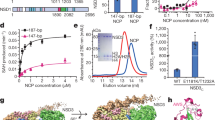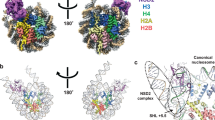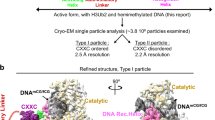Abstract
Histone methylation regulates diverse chromatin-templated processes, including transcription. The recent discovery of the first histone lysine–specific demethylase (LSD1) has changed the long-held view that histone methylation is a permanent epigenetic mark. LSD1 is a flavin adenine dinucleotide (FAD)-dependent amine oxidase that demethylates histone H3 Lys4 (H3-K4). However, the mechanism by which LSD1 achieves its substrate specificity is unclear. We report the crystal structure of human LSD1 with a propargylamine-derivatized H3 peptide covalently tethered to FAD. H3 adopts three consecutive γ-turns, enabling an ideal side chain spacing that places its N terminus into an anionic pocket and positions methyl-Lys4 near FAD for catalysis. The LSD1 active site cannot productively accommodate more than three residues on the N-terminal side of the methyllysine, explaining its H3-K4 specificity. The unusual backbone conformation of LSD1-bound H3 suggests a strategy for designing potent LSD1 inhibitors with therapeutic potential.
This is a preview of subscription content, access via your institution
Access options
Subscribe to this journal
Receive 12 print issues and online access
$189.00 per year
only $15.75 per issue
Buy this article
- Purchase on Springer Link
- Instant access to full article PDF
Prices may be subject to local taxes which are calculated during checkout



Similar content being viewed by others
Accession codes
References
Martin, C. & Zhang, Y. The diverse functions of histone lysine methylation. Nat. Rev. Mol. Cell Biol. 6, 838–849 (2005).
Ruthenburg, A.J., Allis, C.D. & Wysocka, J. Methylation of lysine 4 on histone H3: intricacy of writing and reading a single epigenetic mark. Mol. Cell 25, 15–30 (2007).
Shi, Y. et al. Histone demethylation mediated by the nuclear amine oxidase homolog LSD1. Cell 119, 941–953 (2004).
Shi, Y. & Whetstine, J.R. Dynamic regulation of histone lysine methylation by demethylases. Mol. Cell 25, 1–14 (2007).
Metzger, E. et al. LSD1 demethylates repressive histone marks to promote androgen-receptor-dependent transcription. Nature 437, 436–439 (2005).
Wissmann, M. et al. Cooperative demethylation by JMJD2C and LSD1 promotes androgen receptor-dependent gene expression. Nat. Cell Biol. 9, 347–353 (2007).
Garcia-Bassets, I. et al. Histone methylation-dependent mechanisms impose ligand dependency for gene activation by nuclear receptors. Cell 128, 505–518 (2007).
Yang, M. et al. Structural basis for CoREST-dependent demethylation of nucleosomes by the human LSD1 histone demethylase. Mol. Cell 23, 377–387 (2006).
Stavropoulos, P., Blobel, G. & Hoelz, A. Crystal structure and mechanism of human lysine-specific demethylase-1. Nat. Struct. Mol. Biol. 13, 626–632 (2006).
Chen, Y. et al. Crystal structure of human histone lysine-specific demethylase 1 (LSD1). Proc. Natl. Acad. Sci. USA 103, 13956–13961 (2006).
Banerjee, A., Yang, W., Karplus, M. & Verdine, G.L. Structure of a repair enzyme interrogating undamaged DNA elucidates recognition of damaged DNA. Nature 434, 612–618 (2005).
Zhang, X., Gureasko, J., Shen, K., Cole, P.A. & Kuriyan, J. An allosteric mechanism for activation of the kinase domain of epidermal growth factor receptor. Cell 125, 1137–1149 (2006).
Culhane, J.C. et al. A mechanism-based inactivator for histone demethylase LSD1. J. Am. Chem. Soc. 128, 4536–4537 (2006).
Szewczuk, L.M. et al. Mechanistic analysis of a suicide inactivator of histone demethylase LSD1. Biochemistry (in the press).
Forneris, F., Binda, C., Vanoni, M.A., Battaglioli, E. & Mattevi, A. Human histone demethylase LSD1 reads the histone code. J. Biol. Chem. 280, 41360–41365 (2005).
Zhang, X. et al. Structural basis for the product specificity of histone lysine methyltransferases. Mol. Cell 12, 177–185 (2003).
Hakimi, M.A., Dong, Y., Lane, W.S., Speicher, D.W. & Shiekhattar, R. A candidate X-linked mental retardation gene is a component of a new family of histone deacetylase-containing complexes. J. Biol. Chem. 278, 7234–7239 (2003).
Humphrey, G.W. et al. Stable histone deacetylase complexes distinguished by the presence of SANT domain proteins CoREST/kiaa0071 and Mta-L1. J. Biol. Chem. 276, 6817–6824 (2001).
Shi, Y. et al. Coordinated histone modifications mediated by a CtBP co-repressor complex. Nature 422, 735–738 (2003).
Lee, M.G. et al. Functional interplay between histone demethylase and deacetylase enzymes. Mol. Cell. Biol. 26, 6395–6402 (2006).
Bolden, J.E., Peart, M.J. & Johnstone, R.W. Anticancer activities of histone deacetylase inhibitors. Nat. Rev. Drug Discov. 5, 769–784 (2006).
Otwinowski, Z. & Minor, W. Processing X-ray diffraction data collected in oscillation mode. Methods Enzymol. 276, 307–326 (1997).
Murshudov, G.N., Vagin, A.A. & Dodson, E.J. Refinement of macromolecular structures by the maximum-likelihood method. Acta Crystallogr. D Biol. Crystallogr. 53, 240–255 (1997).
Collaborative Computational Project, Number 4. The CCP4 suite: programs for protein crystallography. Acta Crystallogr. D Biol. Crystallogr. 50, 760–763 (1994).
Emsley, P. & Cowtan, K. Coot: model-building tools for molecular graphics. Acta Crystallogr. D Biol. Crystallogr. 60, 2126–2132 (2004).
Lovell, S.C. et al. Structure validation by Cα geometry: φ,ψ and Cβ deviation. Proteins 50, 437–450 (2003).
Brünger, A.T. et al. Crystallography & NMR system: a new software suite for macromolecular structure determination. Acta Crystallogr. D Biol. Crystallogr. 54, 905–921 (1998).
Acknowledgements
Results shown in this report are derived from work performed at Argonne National Laboratory, Structural Biology Center, at the Advanced Photon Source. Argonne is operated by UChicago Argonne, LLC, for the US Department of Energy, Office of Biological and Environmental Research. This work was supported in part by grants from the US National Institutes of Health (to P.A.C.), the W.M. Keck Foundation (to H.Y.), the Welch Foundation (to H.Y.) and the Leukemia and Lymphoma Society (to H.Y.)
Author information
Authors and Affiliations
Corresponding authors
Ethics declarations
Competing interests
The authors declare no competing financial interests.
Supplementary information
Supplementary Fig. 1
Proposed mechanism of LSD1 inactivation by H3 followed by borohydride reduction. (PDF 474 kb)
Supplementary Fig. 2
Spectral analysis of H3-treated GST-LSD1. (PDF 647 kb)
Supplementary Fig. 3
MALDI-TOF spectrum of H3-FAD conjugate. (PDF 682 kb)
Supplementary Fig. 4
Inhibition of GST-LSD1 by H3. (PDF 1112 kb)
Supplementary Table 1
Kinetic analysis of LSD1 mutant enzymes and dimethyl–H3-K4 peptides. (PDF 41 kb)
Rights and permissions
About this article
Cite this article
Yang, M., Culhane, J., Szewczuk, L. et al. Structural basis of histone demethylation by LSD1 revealed by suicide inactivation. Nat Struct Mol Biol 14, 535–539 (2007). https://doi.org/10.1038/nsmb1255
Received:
Accepted:
Published:
Issue Date:
DOI: https://doi.org/10.1038/nsmb1255
This article is cited by
-
Epigenetic modifications in the development of bronchopulmonary dysplasia: a review
Pediatric Research (2024)
-
LSD1: more than demethylation of histone lysine residues
Experimental & Molecular Medicine (2020)
-
CRISPR-suppressor scanning reveals a nonenzymatic role of LSD1 in AML
Nature Chemical Biology (2019)
-
T-448, a specific inhibitor of LSD1 enzyme activity, improves learning function without causing thrombocytopenia in mice
Neuropsychopharmacology (2019)
-
Epigenetic polypharmacology: from combination therapy to multitargeted drugs
Clinical Epigenetics (2016)



